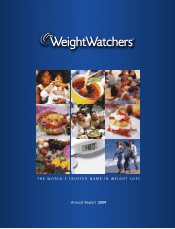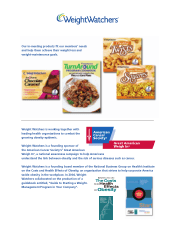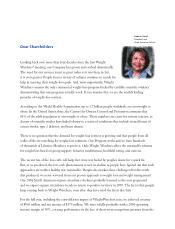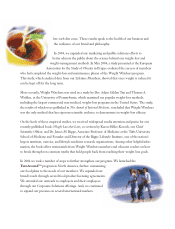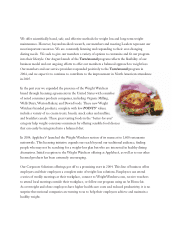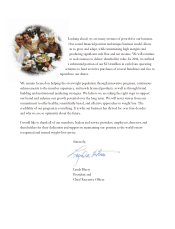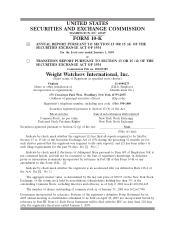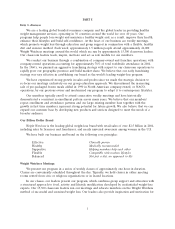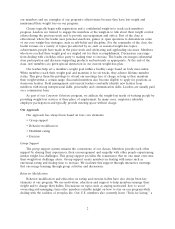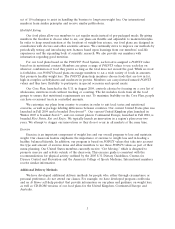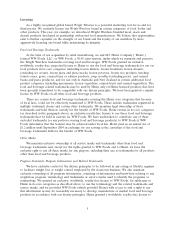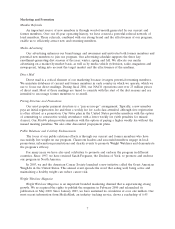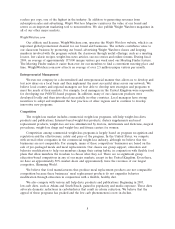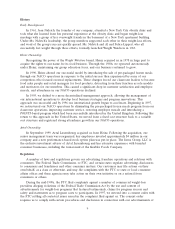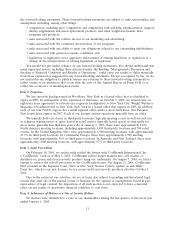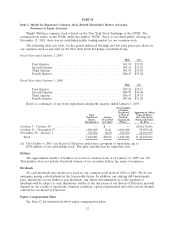WeightWatchers 2004 Annual Report Download - page 11
Download and view the complete annual report
Please find page 11 of the 2004 WeightWatchers annual report below. You can navigate through the pages in the report by either clicking on the pages listed below, or by using the keyword search tool below to find specific information within the annual report.set of 10 techniques to assist in handling the barriers to long-term weight loss. Our international
members learn similar principles and receive similar publications.
Healthful Eating
Our food plans allow our members to eat regular meals instead of pre-packaged meals. By giving
members the freedom to choose what to eat, our plans are flexible and adjustable to modern lifestyles.
In order to keep sound nutrition at the forefront of weight-loss science, our food plans are designed in
consultation with doctors and other scientific advisors. We continually strive to improve our methods by
periodically testing and introducing new features based upon learnings from our members’ real-life
experiences and the expanding body of scientific research. We also provide our members with
information regarding good nutrition.
For our food plans based on the POINTS↧ Food System, each food is assigned a POINTS value
based on its nutritional content. Members are given a range of POINTS values to use each day on
whatever combination of food they prefer so long as the total does not exceed the goal. While no food
is forbidden, our POINTS-based plans encourage members to eat a wide variety of foods in amounts
that promote healthy weight loss. The POINTS plans help members choose foods that are low in fat,
high in complex carbohydrates and moderate in protein. Members can carry-forward unused POINTS
values and thus have flexibility to participate in special occasions and special meals.
Our Core Plan, launched in the U.S. in August 2004, controls calories by focusing on a core list of
wholesome, nutritious foods without tracking or counting. The list includes foods from all the food
groups to ensure that nutritional requirements are met. To maximize livability on the Core Plan, people
can have occasional treats in controlled amounts.
We customize our plans from country to country in order to suit local tastes and nutritional
concerns, as well as package labeling differences between countries. Our current United States plan was
launched in Fall 2004 and is branded TurnAround↩. Our current United Kingdom plan launched in
Winter 2005 is branded Switch↩, and our current plan in Continental Europe, launched in Fall 2004, is
branded Flexi Points, Eat and Enjoy. We typically launch an innovation in a region’s plan every two
years. We attempt to stagger our innovations so they do not occur in all markets at the same time.
Exercise
Exercise is an important component of weight loss and our overall program to lose and maintain
weight. Our classroom leaders emphasize the importance of exercise to weight loss and in leading a
healthy, balanced lifestyle. In addition, our program is based on POINTS values that take into account
the type and amount of exercise done and allow members to use those POINTS values as part of their
menu planning. Our United States members currently receive ‘‘Get Moving,’’ which is designed to
promote exercise and activity outside of the classroom. This exercise guide is consistent with the
recommendations for physical activity outlined by the 2005 U.S. Dietary Guidelines, Centers for
Disease Control and Prevention and the American College of Sports Medicine. International members
receive similar information.
Additional Delivery Methods
We have developed additional delivery methods for people who, either through circumstance or
personal preference, do not attend our classes. For example, we have developed program cookbooks
and an At Home self-help product that provide information on our plans and guidance on weight loss,
as well as CD-ROM versions of our food plans for the United Kingdom, Continental Europe and
Australia.
3

